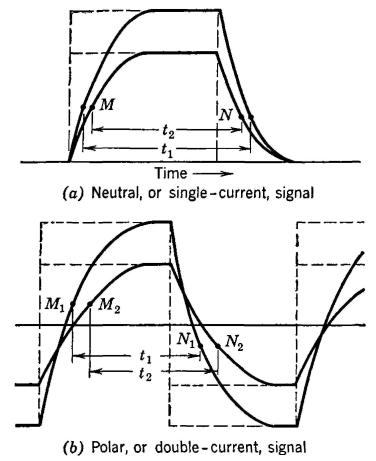| Electrical Communication is a free textbook on the basics of communication technology. See the editorial for more information.... |

|

Home  Telegraph Systems Telegraph Systems  Nature of Currents in Polar, or Double-Current, Systems Nature of Currents in Polar, or Double-Current, Systems |
|||






|
|||
Nature of Currents in Polar, or Double-Current, SystemsThe currents in a neutral, or single-current, system and in a polar, or double-current, system arc shown for comparison in Fig. 9(a). The transmission of current for spacing improves operation as follows: With the neutral, or single-current, system, the closing and opening of the relays and sounders on single current depends on some maximum value M and some minimum value N as in Fig. 9(a). If for any reason the current in the circuit is reduced, the curve will be "flattened," M and N will be closer together, the length to of the signal will be decreased, and distortion will result. With the double-current system this does not occur, as illustrated by Fig. 9(b). If M1 and M2 represent the closing values, and N1 and N2 the opening currents for a polarized relay, it is evident that the two closed periods t1 and t2 depend but little on the maximum current values indicated. Thus, variations in the line constants with weather changes or variations in current strength due to the addition of other stations or equipment in the line do not cause serious distortion.
A double-current system is less affected by changes in insulation resistance than other systems. The leakage currents passing through the relays (Fig. 2) of the single-current system tend to keep the relays energized at all times, even when sending a space. They must therefore be adjusted as marginal relays to operate on changes in the magnitude of the current. Thus, as the line leakage changes, a difficult adjustment of the marginal operation of the relays must be made. With the double-current schemes used in practice, the artificial line (page 323) instead of the relays is adjusted to compensate for line changes.
|
|||
Home  Telegraph Systems Telegraph Systems  Nature of Currents in Polar, or Double-Current, Systems Nature of Currents in Polar, or Double-Current, Systems |
|||
Last Update: 2011-05-30


